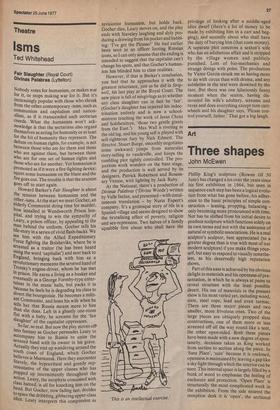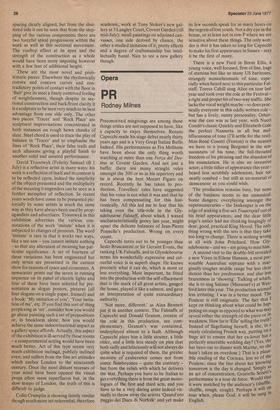Art
Three shapes
John McEwen
Phillip King's sculpture (Rowan till 30 June) has changed a lot over the years since his first exhibition in 1964, but seen in sequence each step has been a logical evolution from what has gone before, his adherence to the basic principles of simple construction — leaning, propping, balancing — only becoming more pronounced with time. Nor has he shifted from his initial desire to produce sculpture which functions solely on its own. terms and not with the assistance of natural or symbolic associations. He is a real sculptor's sculptor, best appreciated (to a greater degree than is true with most of our modern sculptors) if you make things yourself, but easy to respond to visually nonetheless, as his deservedly high reputation shows.
Part of this ease is achieved by his obvious delight in materials and his openness of presentation, in which he is always at pains to reveal structure with the least possible deceit. His use of materials in the present show is his most varied yet, including wood, slate, steel rope, lead and even tarmac. There are three major pieces and two smaller, more frivolous ones. Two of the large pieces are obliquely propped slate constructions, one of them more or less screened off all the way round like a tent, the other open-sided. Both these pieces have been made with a new degree of spontaneity, decisions taken as King worked from section to section along the piece. In 'Sure Place', 'sure' because it is enclosed, openness is maintained by leaving a gap like a sky-light through which the interior can be seen. This internal space is largely filled by a hunk of wood to emphasise the feeling of enclosure and protection. 'Open Place' is structurally the most complicated work in the exhibition. From the side nearest the reception desk it is 'open', the sectional spacing clearly aligned, but from the shuttered side it can be seen that from the stepping of the various components there are two forceful spiral progressions within the work as well as this sectional movement. The rooftop effect at its apex and the strength of the construction as a whole would have been more imposing however with a few feet of additional height.
These are the most novel and problematic pieces. Elsewhere the rhythmically convex and concave curves and contradictory points of contact with the floor in 'Bali' give its steel a finely contrived feeling of weightlessness, though despite its sectional construction and back/front clarity it is a sculpture to be seen very much to its best advantage from one side only. The other two pieces 'Tracer' and 'Rock Place' are sculptural improvisations concentrated in both instances on rough hewn chunks of slate. Steel chord is used to trace the play of balance in 'Tracer' and to emphasise the lines of 'Rock Place', their false trails and arch allusions giving a playful finish to another solid and assured performance.
David Troostwyk (Felicity Samuel till 1 July) is a reflective artist in many ways: his work is a reflection of itself and its content is to be reflected upon, indeed the simplicity of the object presented and the multiplicity of the meaning it engenders can be seen as a further metaphor of reflection. In recent years words have come to be presented pictorially by some artists in much the same way as they have always been used by propagandists and advertisers. Troostwyk in this exhibition advertises the various connotations of the work 'imitate' when it is subjected to changes of pronoun. The word 'imitate' is rare in that it works two ways, like a see-saw — you cannot imitate nothing — so that any alteration of meaning has particular significance.A set of fourteen of these variations has been engineered but only seven are presented in the current show for reasons of space and economics. A newscaster prints out the seven in running sequence on its panel of electric lights and four of these have been selected for presentation as slogan posters, pictures (all four slogans on a single paper, framed) and a book: 'My imitation of you', `Your imitation of me', etc. If you find this sort of thing perplexing as 'art', consider how you would go about painting such a set of propositions or, in bookform alone, how you would achieve the same indoctrinational impact as a gallery space affords. Actually, this aspect of the exhibition is ill-served by these rooms — a compartmental setting would have been much better. Art of this type seems very much exhibition inclined, publicly inclined even, and suffers from the fine art attitudes which anchor London to the nineteenth century. Once the most distant recesses of your mind have been opened the visual props often seem superfluous but, in the slow tempo of London, the truth of this is difficult to judge.
Colin Crumplin is showing faintly similar though much more art referential, therefore academic, work at Tony Stokes's new gallery at 3 Langley Court, Covent Garden (till mid-July): small paintings on adjoined canvasses, one side derived by chance, the other a studied imitation of it; pretty effects and a degree of craftsmanship but intellectually banal. Nice to see a new gallery though.















































 Previous page
Previous page